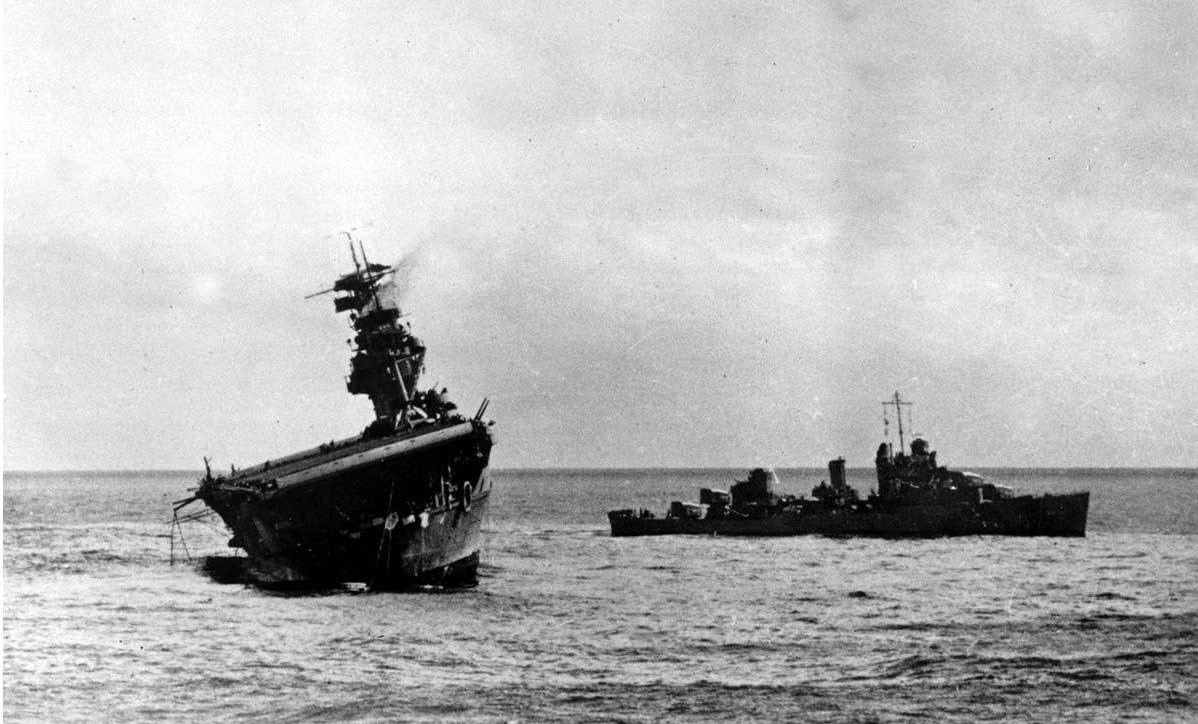June 1942 Battle of Midway

USS Yorktown
In the single most important battle in the Pacific, the US Navy surprised the Japanese invasion fleet sending all four of its carriers to stop the Japanese. Four Japanese carriers were sunk at the loss of one US carrier. The invasion fleet was forced to withdraw. This was the turniing point in the Battle for the Pacific and from this point on the US began its long offensive against the Japanese.
The Japanese High-Command had been divided between those who wanted to consolidate their advances, and those (led by the Navy), who felt the only way to win the war was to decisively defeat the U.S. Navy. After the Doolittle Raid, the Navy received the green light to go ahead. Japanese Naval Chief Yamamoto believed that capturing Midway Island was the key to defeat the U.S. in the Pacific. If Midway could be captured, then Hawaii would be vulnerable. Yamamoto set sail on May 26th 1942 for Midway.
The Americans had broken the main Japanese communication code and were able to determine that Midway was their next target. The U.S. sent a false flag message that Midway was low on water. Then they intercepted a Japanese transmission passing on that information. Admiral Nimitz, commander of U.S. Forces in the Pacific sent Admiral Frank Jack Fletcher- (who commanded a fleet of three Aircraft Carriers: the U.S.S. Enterprise, U.S.S. Hornet and the U.S.S. Yorktown–which had been severely damaged in the Battle of the Coral Sea.) In addition, Fletcher had three Cruisers and 12 Destroyers. Admiral Fletcher faced 11 Japanese Battleships, 8 Carriers, 23 Cruisers and 65 Destroyers.
The deck seemed stacked against Admiral Fletcher, despite his two major advantages: First, Fletcher knew the plans and goals of the Japanese, (while the Japanese were totally unaware that Fletcher was there.) Second, Admiral Fletcher had a type of “limited” aircraft that could be flown off Midway Island itself.
On June 3rd 1942, a Midway-based U.S. aircraft spotted the Japanese fleet approaching. The next morning the Japanese attacked Midway. The American defenders were unable to do very much to blunt the Japanese assault. This gave the Japanese a false sense of security that their enemy would be easy prey. However, the first American attack planes arrived on the scene, as the Japanese aircraft returned from their bombing mission. The Americans sent a squadron of U.S. Navy Devastator torpedo bombers. The entire American squadron was shot down without inflicting any damage on the Japanese. The Japanese commander, Admiral Nagumo Chuichi was convinced that the bombers had come from Midway. Admiral Chuichi ordered his returning planes rearmed for another attack on land. The planes were fully fueled ready to take off, when American dive-bombers appeared from overhead. Within moments, the Japanese Aircraft Carrier Akagi was a blazing tomb, the Kaga and Soryu nearby was similarly set ablaze. The U.S.S. Yorktown was hit by a Japanese counterstrike. The Yorktown was sunk a day later, during a torpedo strike from a Japanese submarine. However, the Americans did succeed in sinking the Hiryu, as well as another Japanese Aircraft Carrier, and to severely damage a Japanese Battleship.
The Americans then withdrew from the battle. They had destroyed four Japanese Aircraft Carriers and downed 250 aircraft– while losing only one U.S. Carrier, (whose aircraft, and most of whose crew survived.) Midway was safe and the tide in the Pacific had shifted.
